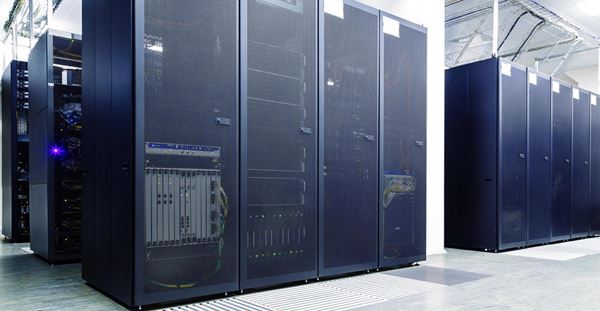Let’s face it, data centers are one of the biggest energy hogs on the planet, often consuming as much as 50 times the energy of an office building of equal size. Estimates on just how much energy the world’s data centers collectively consume vary greatly depending on the source. Recent metrics from The Office of Energy Efficiency & Renewable Energy estimate that US data centers consume approximately 2% of the total electricity use in the United States and that number is expected to grow as our dependence on information technology continues.
In other locations around the world, that percentage is even higher. In Singapore, for example, data centers were reported to have used approximately 7% of that country’s total electricity consumption. Globally, data centers are reported to account for as much as 3% of all electricity usage. It has been suggested that data centers are responsible for up to 5% of all global greenhouse gas emissions. Given the amount of energy consumed by data centers, it is easy to see how even small improvements in energy efficiency can result in significant improvements to the environment.
Liquid Immersion Cooling the future for Data Centers?
Liquid Immersion Cooling has gained a lot of traction in recent years, especially with the advent of cryptocurrency and high-performance computing. There are two types of immersion cooling, single-phase (1-PIC) and two-phase (2-PIC). 1-PIC is where a dielectric liquid remains in the liquid state throughout the cooling process and 2-PIC is where the dielectric liquid changes state and becomes a vapor. The underlying principle of why Liquid Immersion Cooling is so efficient is that liquid is a much better conductor of energy than air. Liquid water, for example, conducts about 22.4 times the amount of energy as air. While, both Liquid Immersion Cooling technologies eliminate the use of CRAHs and CRACs, and may eliminate the use of chillers, each has their own specific advantages over the other. 2-PIC comes with a higher initial cost. However, when looking at total cost of ownership (TCO), the 2-PIC is more favorable due to its slightly lower partial power usage effectiveness (pPUE). With 2-PIC 1.02 - 1.05 is an achievable yearly pPUE (climate dependent), while 1.03 - 1.07 is possible for 1-PIC. Some of the other advantages of 2-PIC over 1-PIC are greater cooling density (higher kW per rack unit), which yields the ability to accommodate higher capacities per rack (over 250kW per rack), and the ability to eliminate the requirement for a cooling distribution unit (CDU).
With 2-PIC, servers are immersed in a bath of dielectric, fluorocarbon-based liquid with a relatively low boiling point compared to 1-PIC. This liquid is in constant contact with the server boards and the heat boils the liquid producing a gaseous vapor through phase change, hence the name 2-PIC. The gas is then condensed back into a liquid using water-cooled condenser coils located at the top of the sealed rack chamber. The condensed liquid is then returned to the fluid in the bottom of the rack chamber to repeat the process.
With 1-PIC, servers are typically immersed in a bath of dielectric, hydrocarbon-based liquid similar to mineral oil with a comparatively higher boiling point. Like 2-PIC, the liquid is in constant contact with the server boards, but here the liquid doesn’t boil. It remains in its liquid state and is cooled in a forced flow manner by pumping the liquid past the heat sinks of the IT load, then through a heat exchanger in a CDU. Hence the name 1-PIC.
Server removal and maintenance is possible with both systems without disturbing and shutting down other equipment in the same bath. The fluid used in 2-PIC will evaporate during removal from the bath and condense on the coils inside the system reducing fluid losses. The 2-PIC server is ready to work on immediately once removed. Typical fluid losses for 2-PIC systems are lower than 2% per year. 1-PIC servers using hydrocarbon-based fluids will require a cleaning station to remove the excess fluid from the server before work can be performed.
With pPUEs approaching unity, Liquid Immersion Cooling is without a doubt the most sustainable and energy efficient method of cooling a data center. In today’s environmental, social, and corporate governance (ESG) market, Liquid Immersion Cooling shows a lot of promise and is quite possibly the future for cooling in data centers.
Is expanding the environmental operating parameters (temperature and humidity) of your data center a viable solution to reducing energy consumption?
The short answer is YES. More and more this is becoming an industry-accepted solution to reducing electricity usage. Simply put, by increasing temperature and relaxing humidity ranges, you can reduce your data center’s mechanical cooling energy consumption.
Historically, data centers have exercised strict controls over their operating temperature and humidity, typically within a temperature range of 68oF to 72oF (20oC to 22oC) in combination with a humidity range of 40% to 55% RH. This resulted in needlessly wasted energy due to the increased cooling requirements. In the past, the impacts of extending the environmental operation parameters on information technology (IT) equipment had not been fully studied or understood. Thanks to research by companies like Facebook, Intel, and The Green Grid coupled with newly published ASHRAE data, the effects of higher operating parameters on IT equipment reliability and service availability have been determined to not be as detrimental as previously thought.
New ASHRAE data suggests that vendors of class A3 devices can support operational temperatures up to 104oF (40oC). Let’s be honest, even with the improvements in IT equipment efficiency, allowing them to operate at higher temperatures does increase their failure rate, but as it turns out, not significantly. This assumes that the increases are within ASHRAE recommended and allowable guidelines. Of course, there are other factors to consider when operating a data center at higher temperatures. These include the health and safety for operations personnel, PUE irregularities associated with server fan power, and airflow optimization to name a few. Assuming an average server replacement cycle in the range of three to five years, the increased failure rate due to the impacts of higher temperature and humidity may be a moot point, since the equipment will typically be replaced with newer technology before it can fai
Are Battery Energy Storage Systems (BESS) a viable replacement for diesel generators?
It has been estimated that there are more than 20 gigawatts of backup diesel generators in service globally across the data center industry today. I have been touting the benefits of replacing diesel generators with BESS for many years now. In September of 2019 at the Critical Facilities Summit in Dallas, I co-presented a presentation titled ‘Backup Power: New Approaches via UPS, Energy Storage & EV Technologies’ with a long-time friend and associate, Michael Fluegeman, PE. In that presentation, we discussed how diesel generators have been providing long-term backup power to critical facilities for decades. Their long-term negative impacts to the environment are well documented and undeniable. Thanks to improvements in the cost and performance of rectifier/chargers, inverters, high-speed power switching, control systems and, more specifically, new battery technologies, we now have viable alternatives for their replacement. Currently, Lithium-ion batteries dominate the BESS industry and their pros and cons have been discussed and debated ad nauseam. They are expensive, don’t like being fully charged or discharged, extremely sensitive to high temperatures, and inherently flammable.
The biggest problem with BESS as replacements for diesel generators is that data centers and other critical facilities require long-term backup power sometime for days at a time. Current BESS typically are designed to provide backup power for no more than 4-hours. Unless combined with more traditional backup systems, BESS are only feasible when utilized for short duration outages of 4 hours or less. Fortunately, the average US electricity customer experienced just over eight hours of power interruptions in 2020. That’s for the whole year. The best states average between 44 minutes to 101 minutes for individual outages. The worst states average considerably more, ranging from 29 hours to a whopping 60 hours. The fact remains that most non-major event outages are less than 2 hours. If the outage was anticipated to last more than 2 hours, having the ability to engage more traditional diesel or natural gas generators early enough would allow the recharging of the BESS and thereby extend the 4-hour window out to perhaps 8 hours or more. This would cover an even greater percentage of annual outages. If an outage lasted greater than 8 hours, as might be the case in a major natural disaster, one could implement load shedding protocols to extend the 8 hours even further or utilize remote backup facilities. The environment, with a substantial reduction in GHG emissions, would be the greatest beneficiary of such a hybrid configuration. Fortunately, new advances in battery technology are extending the duration of BESS and in doing so may all but eliminate the need for such hybrid configurations. Recently, California Community Power (CC Power) announced the first 8-hour, long-duration, lithium-ion battery energy storage resource project. Project Tumbleweed will have a 69MW output and 552MWh capacity operational by 2026.
The advantages of BESS over diesel generators are numerous. Diesel generators have issues with increasingly more regulated emissions, noise, and fuel storage. They also required regular testing/exercising as well as regular maintenance to insure reliability. By comparison, BESS are fast, reliable, virtually maintenance free, require no fuel storage, are quiet, environmentally friendly, and can last for 20 years or more.
In July of 2020, Microsoft announced that it would eliminate its reliance on diesel fuel by the year 2030. In December of that same year, Google announced they would be using large BESS to replace the diesel generators at one of their data centers in Belgium. Just this month, Meta, Facebook’s parent company, announced the setting up of a consortium to measure the emissions benefits of using large BESS. More recently, Microsoft announced they would be installing high temperature, ‘liquid metal’ batteries manufactured by new company, Ambri, for backing up one of their data centers, but the capacity and location were not disclosed. In May of 2021, Ambri teamed with data center provider Terascale to provide 250MWh of renewable energy battery storage at the Tahoe Reno Industrial Center.
Ambri was founded by MIT professor of materials chemistry, Donald Sadoway, with Microsoft founder Bill Gates being their largest shareholder. Liquid metal battery systems show promise and are positioned to replace lithium-ion in larger scale BESS installations. Elements of Antimony and Calcium Alloy are combined with a solid salt electrolyte inside a sealed, insulated, and positively polarized stainless-steel case with a negative terminal at the top. The contents are then heated to 500oC (932oF) at which point the metals and electrolyte become molten. The discharge process generates its own heat eliminating the need for an external heat source. With an efficiency of 80% and the ability to undergo tens of thousands of charge/discharge cycles with little to no degradation or drop in efficiency, liquid metal batteries easily outperform lithium-ion. In addition, unlike lithium-ion batteries, their high operating temperature does not require cooling, making them suitable for any climate. As far as safety goes, liquid metal batteries have no safety issues compared to those plaguing lithium-ion batteries.
The winds of change are in the air and the data center industry has the ability to drive meaningful change on global warming climate issues. These are just a few environmentally friendly data center trends to keep an eye on as we move towards achieving our sustainability goals.





